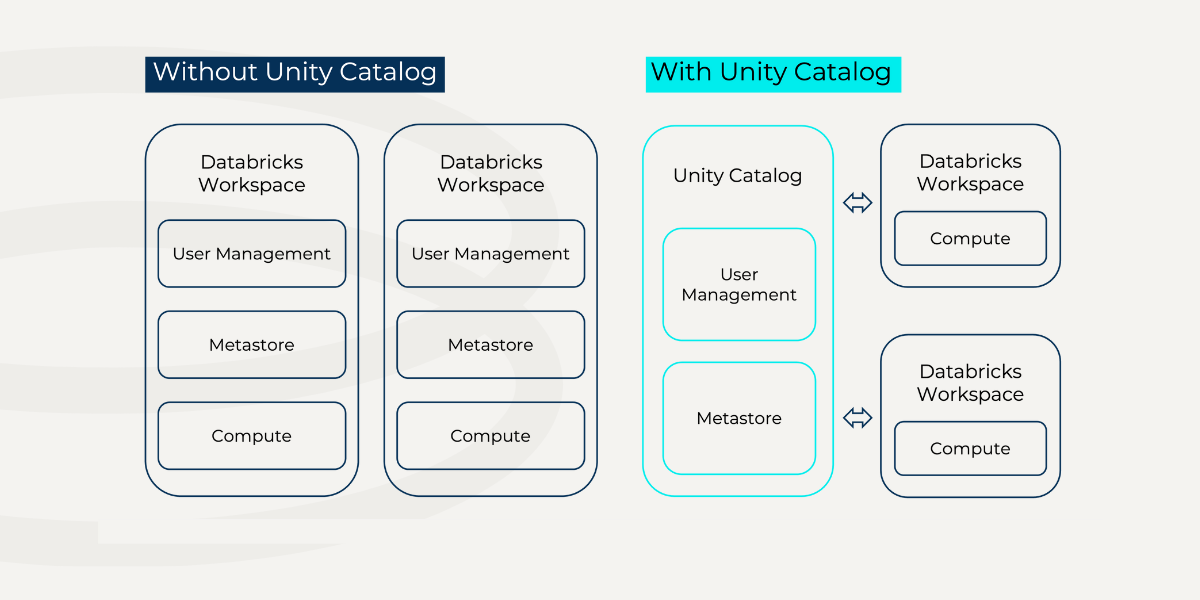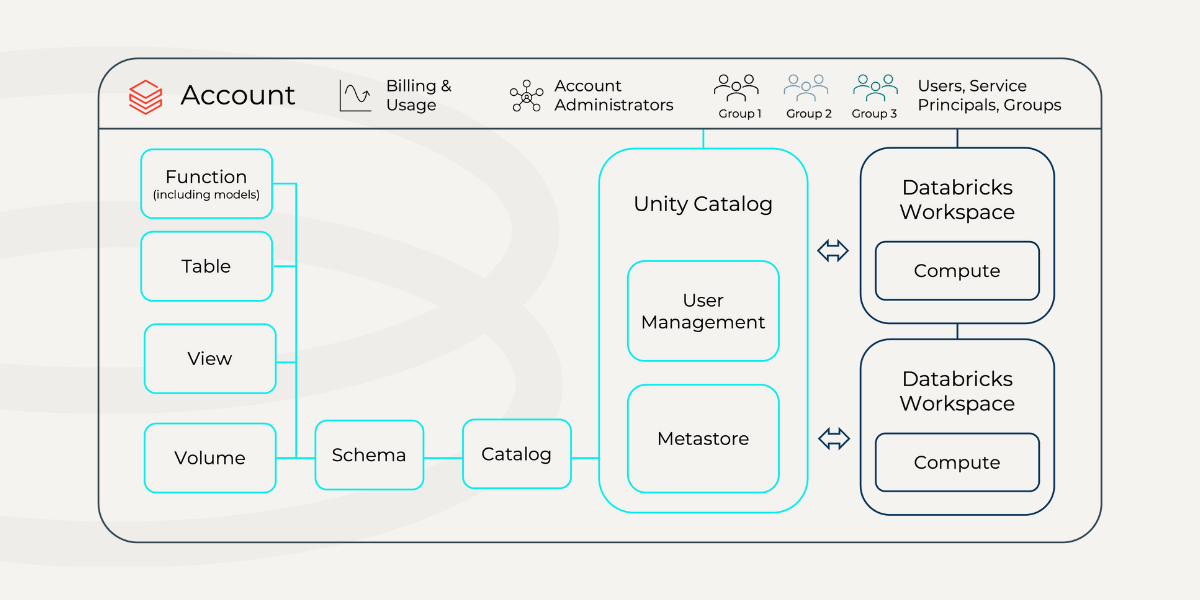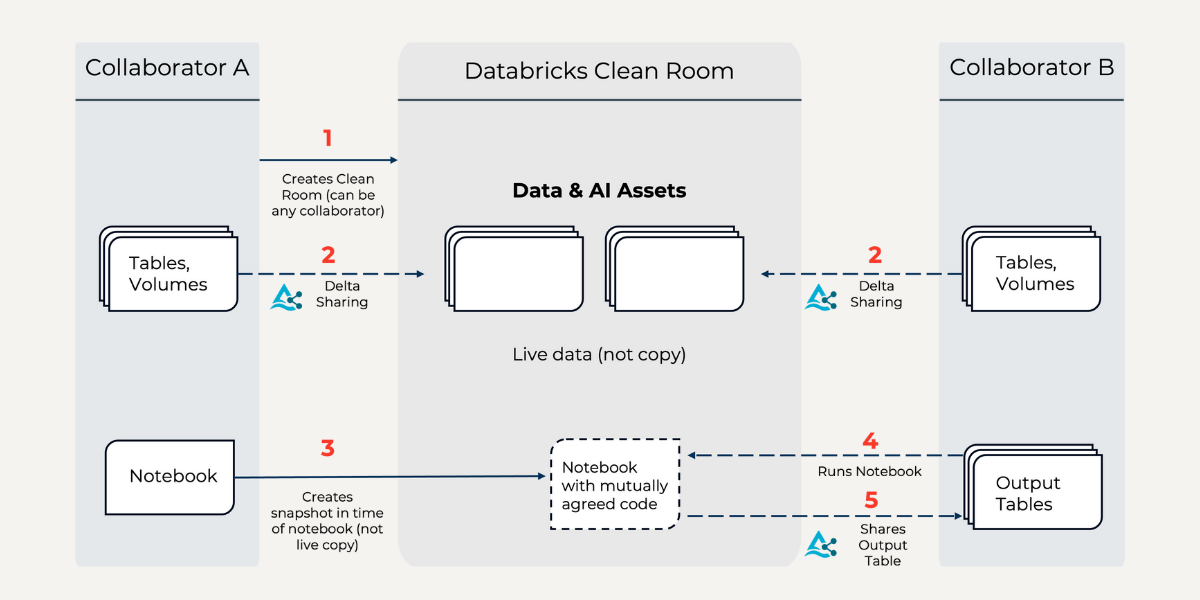.png)
Every organisation dealing with data at scale eventually faces the same problems: scattered permissions, unclear ownership and no simple way to trace how data flows through pipelines. Unity Catalog is Databricks’ unified governance layer for data and AI assets. It gives organisations one place to define access policies, capture audit logs, track end-to-end lineage and discover assets across all your workspaces.

Define Once, Secure Everywhere
Centralised Access Control
Standards-Compliant Security Model
Auditing and Lineage
Data Discovery
Managing data at scale often leads to confusion over where data lives, who owns it, and how access should be structured. Without a clear framework, enforcing consistent governance across workspaces and teams becomes difficult. Unity Catalog solves this with a logical, layered hierarchy that organises all data assets and permissions & roles from the account level down to individual tables and views making governance scalable and transparent.
1. Account Level
This is the highest level in the hierarchy, representing your entire Databricks account.
2. Workspace Level
Workspaces are environments where users collaborate, run notebooks, and access data.
3. Metastore Level
The metastore is the top-level container for data governance in Unity Catalog. It stores metadata and manages access controls for all objects within it. Below the metastore, Unity Catalog uses a three-level hierarchy to organise and control securable data objects:

Different admins manage different parts of this hierarchy, with clearly defined responsibilities:

Unity Catalog keeps a detailed record of every action in your metastore. This means you can see exactly who looked at or changed any dataset, and what they did. The audit information is available through system tables in Unity Catalog, so you can run SQL queries to review access logs, spot unusual behaviour and meet compliance requirements.
Understanding how data moves and transforms within an organisation is crucial for troubleshooting, auditing, and ensuring trust in data. Unity Catalog automatically captures end-to-end data lineage, providing visibility into data sources, transformations, and downstream usage.
This makes it easier to track changes, diagnose errors, and verify data integrity. For compliance-heavy industries, automated lineage tracking simplifies regulatory audits by offering a clear record of how data is used across various workflows.

Delta Sharing lets you share tables, views or files in your cloud storage to partners, vendors or other teams without copying data. Permissions you’ve set in Unity Catalog carry over to these shares. For scenarios requiring tighter controls, clean rooms provide an isolated compute environment where multiple parties can collaborate on data without exposing raw tables to each other. You define the exact transformations allowed, and all outputs remain governed by the providers predefined access control.

(Announced at the 2025 Data + AI Summit: now in Public Preview across AWS, Azure, and GCP)
As the lakehouse evolves, so does the need to treat metrics as first-class citizens. Traditionally, KPI’s and business metrics are scattered across dashboards, embedded SQL, or spreadsheets, leading to inconsistencies, errors, and duplication. Unity Catalog Metrics solves this by allowing you to define governed, reusable metric views directly in Unity Catalog.
These metrics are:
This means Finance, BI, and Data Science teams can all rely on the same version of "monthly revenue", "active users", or "conversion rate" across the organisation without reimplementing logic in every tool.
In the evolving landscape of modern data and AI platforms, governance is a baseline necessity. Unity Catalog isn’t just a tool for access control; it’s a strategic foundation for secure collaboration, data discoverability, and regulatory compliance across your entire organisation.
We’ve delivered solutions with Unity Catalog as the central governance layer for clients across various industries and have seen firsthand how it enables faster project delivery, reduces risk, and builds trust in data and AI outcomes. From streamlining access in highly regulated multi tenancy environments to simplifying lineage for complex pipelines, Unity Catalog has proven to be a critical enabler of both agility and control.
As your data estate grows, so does the importance of having a clear, scalable governance framework. With Databricks’ Unity Catalog, you're not only protecting your assets, you’re creating the foundation for trusted, collaborative, and future-ready data and AI projects.
Every organisation dealing with data at scale eventually faces the same problems: scattered permissions, unclear ownership and no simple way to trace how data flows through pipelines. Unity Catalog is Databricks’ unified governance layer for data and AI assets. It gives organisations one place to define access policies, capture audit logs, track end-to-end lineage and discover assets across all your workspaces.

Define Once, Secure Everywhere
Centralised Access Control
Standards-Compliant Security Model
Auditing and Lineage
Data Discovery
Managing data at scale often leads to confusion over where data lives, who owns it, and how access should be structured. Without a clear framework, enforcing consistent governance across workspaces and teams becomes difficult. Unity Catalog solves this with a logical, layered hierarchy that organises all data assets and permissions & roles from the account level down to individual tables and views making governance scalable and transparent.
1. Account Level
This is the highest level in the hierarchy, representing your entire Databricks account.
2. Workspace Level
Workspaces are environments where users collaborate, run notebooks, and access data.
3. Metastore Level
The metastore is the top-level container for data governance in Unity Catalog. It stores metadata and manages access controls for all objects within it. Below the metastore, Unity Catalog uses a three-level hierarchy to organise and control securable data objects:

Different admins manage different parts of this hierarchy, with clearly defined responsibilities:

Unity Catalog keeps a detailed record of every action in your metastore. This means you can see exactly who looked at or changed any dataset, and what they did. The audit information is available through system tables in Unity Catalog, so you can run SQL queries to review access logs, spot unusual behaviour and meet compliance requirements.
Understanding how data moves and transforms within an organisation is crucial for troubleshooting, auditing, and ensuring trust in data. Unity Catalog automatically captures end-to-end data lineage, providing visibility into data sources, transformations, and downstream usage.
This makes it easier to track changes, diagnose errors, and verify data integrity. For compliance-heavy industries, automated lineage tracking simplifies regulatory audits by offering a clear record of how data is used across various workflows.

Delta Sharing lets you share tables, views or files in your cloud storage to partners, vendors or other teams without copying data. Permissions you’ve set in Unity Catalog carry over to these shares. For scenarios requiring tighter controls, clean rooms provide an isolated compute environment where multiple parties can collaborate on data without exposing raw tables to each other. You define the exact transformations allowed, and all outputs remain governed by the providers predefined access control.

(Announced at the 2025 Data + AI Summit: now in Public Preview across AWS, Azure, and GCP)
As the lakehouse evolves, so does the need to treat metrics as first-class citizens. Traditionally, KPI’s and business metrics are scattered across dashboards, embedded SQL, or spreadsheets, leading to inconsistencies, errors, and duplication. Unity Catalog Metrics solves this by allowing you to define governed, reusable metric views directly in Unity Catalog.
These metrics are:
This means Finance, BI, and Data Science teams can all rely on the same version of "monthly revenue", "active users", or "conversion rate" across the organisation without reimplementing logic in every tool.
In the evolving landscape of modern data and AI platforms, governance is a baseline necessity. Unity Catalog isn’t just a tool for access control; it’s a strategic foundation for secure collaboration, data discoverability, and regulatory compliance across your entire organisation.
We’ve delivered solutions with Unity Catalog as the central governance layer for clients across various industries and have seen firsthand how it enables faster project delivery, reduces risk, and builds trust in data and AI outcomes. From streamlining access in highly regulated multi tenancy environments to simplifying lineage for complex pipelines, Unity Catalog has proven to be a critical enabler of both agility and control.
As your data estate grows, so does the importance of having a clear, scalable governance framework. With Databricks’ Unity Catalog, you're not only protecting your assets, you’re creating the foundation for trusted, collaborative, and future-ready data and AI projects.